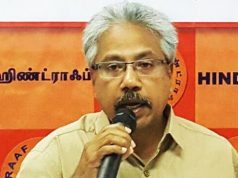PETALING JAYA, SEPT 12- Persatuan Hindraf Malaysia today gave itself thumbs down in its 100-day report card, in regards to the implementation of the blueprint it signed with the Barisan Nasional (BN) government.
In a statement today, Hindraf adviser N Ganesan outlined 23 key issues that they were supposed to address and achieve outcomes within 100 days of being appointed into the mainstream national administration.


“But most of the items are still work in progress. One of the major issues we are facing is the setting up of an expert steering committee to work on the implementation of the blueprint,” he said.
However, Ganesan indicated in the report that to-date Hindraf chief, P Waythamoorthy has only manage to set up a unit under the PMO and nothing else has progressed forward for the moment.
By far even the unit has yet to be named.
Nevertheless, Ganesan defended Hindraf’s performance, saying that the setting up of the unit under the PMO was the first step in addressing the plight of the poor Malaysian Indians.
“I understand that our performance is not satisfactory for now but it involves ongoing work.
“It is a learning process for us and we believe our performance will pick up with the approaches we are taking right now,” he said.
The MoU signed between BN and Hindraf just before the May general election includes a five-year blueprint to bring the poor Malaysian Indian into the mainstream national development, to boost their standard of living.
Following the MoU, Hindraf had urged the Indian community to back the BN in the GE. Previously Hindraf was known for their hard anti-BN stand.
After the general election, Waythamoorthy was appointed as deputy minister in the PMO to monitor the implementation of the MoU.
The MoU, among others, highlights issues related to displaced Indian plantation workers, the need for tertiary-level education for Indian students, job opportunities in the government sector, financial loans to Indian entrepreneurs, and the establishment of a special unit for the Indian community.









